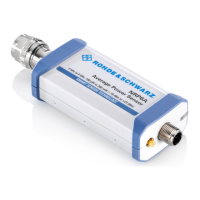Remote Control Commands
R&S
®
NRPxxA(N)
95User Manual 1177.6017.02 ─ 05
Remote commands:
[SENSe<Sensor>:]CORRection:DCYCle............................................................................ 95
[SENSe<Sensor>:]CORRection:DCYCle:STATe..................................................................95
[SENSe<Sensor>:]CORRection:DCYCle <duty_cycle>
Available in continuous average mode.
Sets the duty cycle for measuring pulse-modulated signals. The duty cycle defines the
percentage of one period during which the signal is active. If the duty cycle is enabled,
the R&S NRPxxA(N) takes this percentage into account when calculating the signal
pulse power from the average power.
Parameters:
<duty_cycle> Range: 0.001 to 100.00
*RST: 1.00
Default unit: Percent
Manual operation: See "Duty Cycle" on page 47
[SENSe<Sensor>:]CORRection:DCYCle:STATe <state>
Enables or disables the duty cycle correction for the measured value.
Parameters:
<state> *RST: OFF
Manual operation: See "Duty Cycle" on page 47
9.8.3.2 Offset Corrections
The offset accounts for external losses by adding a fixed level offset in dB.
The attenuation of an attenuator located ahead of the sensor (or the coupling attenua-
tion of a directional coupler) is taken into account with a positive offset, i.e. the sensor
calculates the power at the input of the attenuator or the directional coupler. A negative
offset can be used to correct the influence of an amplifier connected ahead.
Using S-parameters instead of a fixed offset allows more precise measurements,
because the interaction between the sensor and the component can be taken into
account. See also Chapter 9.8.3.3, "S-Parameter Correction", on page 96.
Remote commands:
[SENSe<Sensor>:]CORRection:OFFSet............................................................................ 95
[SENSe<Sensor>:]CORRection:OFFSet:STATe.................................................................. 96
[SENSe<Sensor>:]CORRection:OFFSet <offset>
Sets a fixed offset that is added to correct the measured value.
Configuring Basic Measurement Parameters

